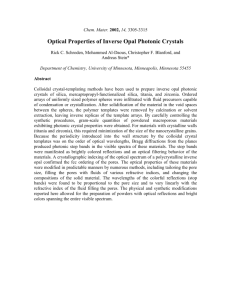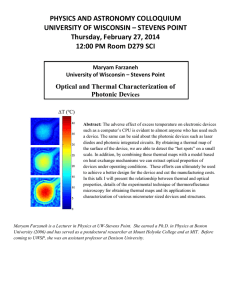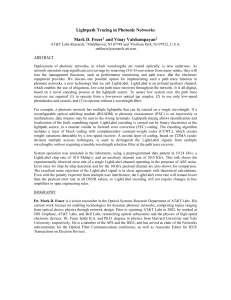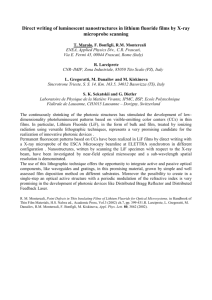High-Q CMOS-integrated photonic crystal microcavity devices Please share
advertisement
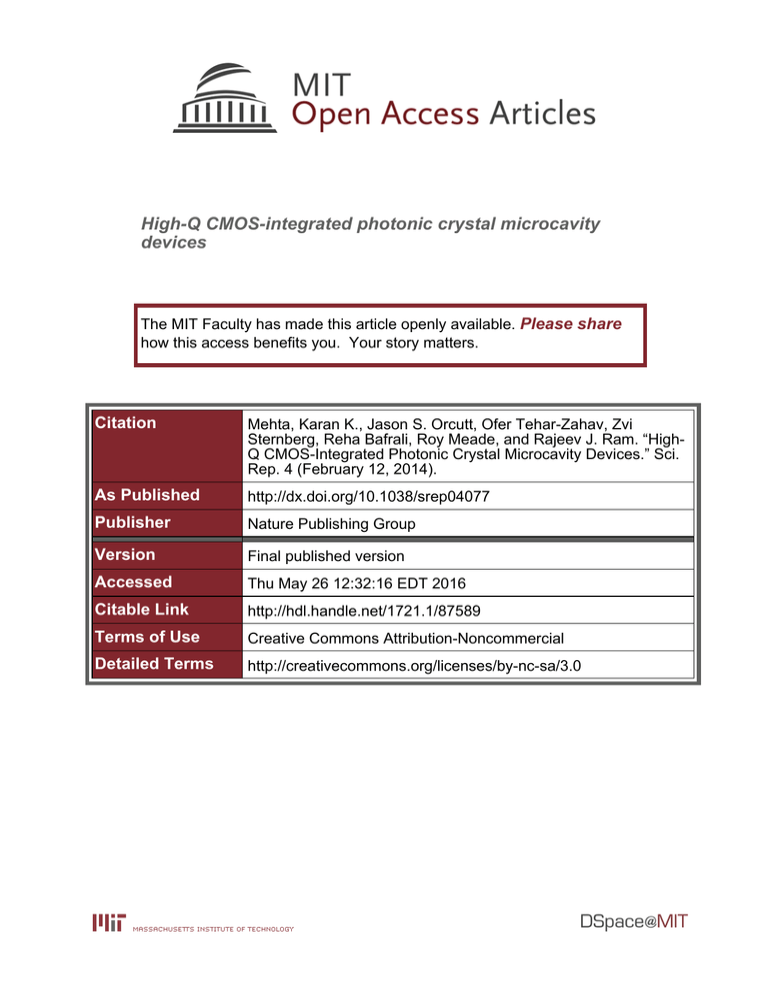
High-Q CMOS-integrated photonic crystal microcavity
devices
The MIT Faculty has made this article openly available. Please share
how this access benefits you. Your story matters.
Citation
Mehta, Karan K., Jason S. Orcutt, Ofer Tehar-Zahav, Zvi
Sternberg, Reha Bafrali, Roy Meade, and Rajeev J. Ram. “HighQ CMOS-Integrated Photonic Crystal Microcavity Devices.” Sci.
Rep. 4 (February 12, 2014).
As Published
http://dx.doi.org/10.1038/srep04077
Publisher
Nature Publishing Group
Version
Final published version
Accessed
Thu May 26 12:32:16 EDT 2016
Citable Link
http://hdl.handle.net/1721.1/87589
Terms of Use
Creative Commons Attribution-Noncommercial
Detailed Terms
http://creativecommons.org/licenses/by-nc-sa/3.0
OPEN
SUBJECT AREAS:
MICRO-OPTICS
OPTICS AND PHOTONICS
Received
20 August 2013
Accepted
27 January 2014
Published
12 February 2014
Correspondence and
requests for materials
should be addressed to
K.K.M. (karanm@mit.
edu)
* Current address:
High-Q CMOS-integrated photonic
crystal microcavity devices
Karan K. Mehta1, Jason S. Orcutt1, Ofer Tehar-Zahav2*, Zvi Sternberg2, Reha Bafrali3, Roy Meade4
& Rajeev J. Ram1
1
Department of Electrical Engineering & Computer Science and Research Laboratory of Electronics, Massachusetts Institute of
Technology, Cambridge, MA, USA 02139, 2Micron Semiconductor Israel, Kiryat-Gat, Israel, 3Micron Technology, Inc., Process
R&D, San Jose, CA, USA 95134, 4Micron Technology, Inc., Process R&D, Boise, ID, USA 83707.
Integrated optical resonators are necessary or beneficial in realizations of various functions in scaled
photonic platforms, including filtering, modulation, and detection in classical communication systems,
optical sensing, as well as addressing and control of solid state emitters for quantum technologies. Although
photonic crystal (PhC) microresonators can be advantageous to the more commonly used microring devices
due to the former’s low mode volumes, fabrication of PhC cavities has typically relied on electron-beam
lithography, which precludes integration with large-scale and reproducible CMOS fabrication. Here, we
demonstrate wavelength-scale polycrystalline silicon (pSi) PhC microresonators with Qs up to 60,000
fabricated within a bulk CMOS process. Quasi-1D resonators in lateral p-i-n structures allow for resonant
defect-state photodetection in all-silicon devices, exhibiting voltage-dependent quantum efficiencies in the
range of a few 10 s of %, few-GHz bandwidths, and low dark currents, in devices with loaded Qs in the range
of 4,300–9,300; one device, for example, exhibited a loaded Q of 4,300, 25% quantum efficiency
(corresponding to a responsivity of 0.31 A/W), 3 GHz bandwidth, and 30 nA dark current at a reverse bias
of 30 V. This work demonstrates the possibility for practical integration of PhC microresonators with active
electro-optic capability into large-scale silicon photonic systems.
Intel Israel (74) LTD.,
Haifa, Israel.
O
ptical microresonators1 enable or enhance a diverse set of functions in integrated optical systems,
spanning filtering and routing2, switching and modulation3, control of light emission4, photodetection,
and sensing. Low-volume optical modes are advantageous for a variety of reasons in all of these
applications; examples include smaller footprint for dense integration, greater sensitivity to local index perturbations for sensors, greater energy efficiency in tuning for modulation, lower capacitance devices, stronger nonlinear interactions, and coupling to light emitters such as quantum dots and atoms. As a result, due to their ability
to support very high-quality-factor (Q) resonant optical modes with mode volumes on the order of (l/n)3 or less,
PhCs have attracted interest from a broad range of fields in recent years5–9. Much progress has been made in the
optimization and fabrication of such structures, but due to the ,100-nm feature sizes required for structures with
photonic bandgaps in the optical or near-infrared, fabrication typically relies on electron-beam lithography. This
has limited the practical use of PhC structures, since it precludes practical integration with large-scale photolithographically defined systems, and also makes challenging the creation of complex structures requiring multiple masks9.
Although the possibility for photolithographically defined quasi-2D PhCs has been explored in the past10,11,
high-Q resonators proved difficult to achieve. Passive optical cavities with measured quality factors (and extracted
intrinsic Qs) of approximately 3,000 (10,000)12 and 2,200 (on the order of 100,000)13 have been designed and
fabricated in SOI CMOS processes, but the potential for reliably creating active electro-optical devices in electrically-contacted PhC cavities capable of Qs exceeding 105 in a scalable process has remained unexplored.
In this work, we demonstrate PhC microresonators with radiation-loss limited Qs well in excess of 105 and
measured material loss-limited Qs up to 58,000, fabricated photolithographically within a scaled CMOS process
in the same patternable polycrystalline silicon (pSi) layer as used for transistor gates. A 1.2 mm thick, patterned
oxide beneath optical devices eliminates the need for undercuts or any post-fabrication processing. We introduce
also a laterally electrically-contacted design for a quasi-1D resonator utilizing a patterned, partially etched silicon
layer, and demonstrate electro-optic functionality in the form of defect-state photodetection in a resonant p-i-n
structure which allows efficient photodetection at 1550 nm wavelengths in an all-silicon CMOS device. These
results indicate the potential for high-Q PC resonators to achieve both passive and active optical functionalities in
scaled photonic systems, in a way that can be straightforwardly integrated with sophisticated electronics14. The
SCIENTIFIC REPORTS | 4 : 4077 | DOI: 10.1038/srep04077
1
www.nature.com/scientificreports
work indicates the practicality of silicon PhC microcavity devices for
application in the near term for silicon photonic interconnects15–17
and more speculatively in the long term for integrated quantum
photonic systems18.
Results
A schematic chip cross section around the pSi layer in the process
used is shown in Fig. 1(a), showing p- and n-mos transistors and
doping profiles in the crystalline silicon substrate. Passive optical
structures can be formed within the undoped pSi used as the transistor gates, and losses down to 6 dB/cm at 1550 have been previously
reported in waveguides formed in this layer19. A partial etch step
allows thin wings to sit adjacent to the waveguide cores, which can
be doped and electrically contacted with metal vias which access
three patternable copper wiring layers. A conformal silicon-nitride
(n < 2.0) layer encloses the pSi, and fills the holes in these designs
which are otherwise SiO2-clad, resulting in a lower index contrast
than the Si/air structures which have achieved the highest Q/V ratios.
A 193 nm photolithography process with 0.68 numerical aperture
was used to define features in the pSi. 100-nm features transferred to
a photoresist using such illumination can suffer significant optical
proximity effects10, and here an optical proximity correction (OPC)
algorithm partially compensated for such effects in definition of the
circular holes; Fig. 1(d) shows the OPC-generated mask pattern for a
triangular lattice of circular holes, and an example SEM image of a
2D lattice fabricated, with 375 nm lattice constant. From a set of SEM
images on devices with a variety of lattice constants (a) and hole radii,
an approximately linear relation between specified and achieved hole
radii was found that was independent of lattice constant, and was
used to compensate for uniform lithographic bias in future designs in
the same process. Holes with radii down to about 55 nm formed
reliably.
A variety of previously studied PC microcavity designs would be
suitable for integration here. Minimization of radiative loss into the
cladding motivates choice of cavities with smooth, ideally Gaussian
envelopes5,20,21, and quasi-1D structures, relying on photonic bandgap confinement in only one direction, are particularly robust in
moderate index-contrast environments22. The bulk of our devices
relied on such cavities.
Quasi-1D resonators for operation near 1550 nm using a linear
array of holes in a 225 nm-height pSi waveguide of width < 450 nm
were designed with a lattice constant a near 330 nm, based on the
hole tapering scheme developed in23. Around the cavity center to
either side, hole radii decrease linearly from r 5 0.33a to r 5
0.28a; a set of ‘‘mirror’’ holes, all with r 5 0.28a are added to either
side, the number of which controls the strength of coupling to the
feeding bus waveguides24. In the dielectric environment here, these
resonators achieve intrinsic (that is, with no coupling to the feeding
waveguides) radiative Qs of over 2 million, as calculated with finitedifference time-domain (FDTD) simulations25 without material loss.
To allow efficient electrical contact to the resonator without introducing large optical loss, thin < 50 nm-thick pSi ‘‘wings’’ were
Figure 1 | (a) Photograph of full wafer, on which a single reticle (inset) was repeated. The location of the PhC devices discussed here is labeled
within the inset. (b) Schematic chip cross-section (not to scale), illustrating (from left to right) doping profiles around nmos and pmos transistors with
metal vias and copper wiring, intrinsic pSi waveguide structures separated from the silicon substrate by a 1.2 mm-thick Deep Trench Isolation (DTI)
deposited oxide, and a doped and contacted electro-optic structure. (c) Detailed schematic including dimensions near optical cores. (d) Transformation
of supplied (desired) pattern to mask design after optical proximity correction, and SEM images of 2D lattice of fabricated holes in pSi.
SCIENTIFIC REPORTS | 4 : 4077 | DOI: 10.1038/srep04077
2
www.nature.com/scientificreports
placed adjacent to the cavity. However, continuous slabs, in conjunction with the SiN liner layers, had effective indices large enough to
couple to some Fourier components of the resonant mode, resulting
in optical leakage, which could be reduced by patterning the wings
with a 2D lattice of triangular low index holes; this had the effect also
of reducing the resonant mode field’s evanescent decay into the
wings, allowing doped regions to be brought closer to the cavity
(see Supplementary Information). This patterning was done with a
lattice of r 5 0.3a holes here. An SEM image of a resulting structure
along with the FDTD-calculated resonant electric field profile is
shown in Fig. 2(b). The intrinsic radiative Q of the contacted structure was calculated to be < 300,000, and the mode volume 0.8(l/n)3.
Light is coupled to independent devices via grating couplers from
fibers oriented nearly normal to the chip surface; adiabatic tapers
couple to the < 500 nm-wide waveguides, as shown in the optical
micrograph of Fig. 2(a). Transmission spectra through cavities with
resonant wavelengths l0 5 1510 nm and l0 5 1540 nm, with three
different waveguide coupling strengths (8, 12, and 18 pairs of mirror
holes) are shown in Fig. 2(c) and (d), along with theoretical fits to
Fano profiles26 which allowed determination of each cavity’s loaded
quality factor. The peak transmissions of each cavity, measured and
normalized to the grating coupler transmission loss calibrated separately, closely follow the theoretical prediction of a standard coupled
mode analysis Tpk 5 (Qtot/QWG)2 27. Here the total measured quality
factor is related to the waveguide coupling strength via the relation
{1
{1
Q{1
tot ~Q0 zQWG , where Q0 is the cavity’s intrinsic loss rate (due to
material and radiative loss) and QWG is the quality factor associated
only with the cavity loss rate into the bus WG modes. As shown in
Fig. 2(e), the peak transmissions and measured total quality factors
are closely fit by the theoretical prediction for intrinsic quality factors
Q0 5 58,000 and 51,000.
These loss rates are thus clearly limited not by the device design,
but predominantly from material loss in the pSi and fabrication
imperfections. Characterization of propagation loss in rectangular
waveguides on the same wafer gives insight into the role of
bulk material loss as well as sidewall roughness. The intensity loss
coefficient of the bulk material in these samples is measured to be
approximately a < 4 dB/cm < 0.92 cm21, corresponding to a temporal photon loss rate of c 5 ac/ngr < 8 GHz, where ngr is the
waveguide group index. This results in a material loss-associated Q
of Qmat 5 v/c < 154,000. However, sidewall roughness makes a
significant contribution to loss in these devices as well. Rectangular
waveguides of 400 nm width, in which the mode profile has significant overlap with the sidewalls, exhibited propagation losses of about
8.5 dB/cm at the wavelengths of interest. Although the overlap with
the sidewalls in the PhC cavities can be expected to be only roughly
that of the fundamental mode in the 400 nm rectangular waveguide,
this measured loss would correspond to a total Qmat 1 roughness < 77,
000.
Variance in fabricated hole sizes could play a role as well; scatter2
ing loss has been resulted to scale approximately as Q{1
dis ~Aðsr =aÞ ,
28,29
where sr represents the RMS radius deviation
and A represents a
design and index-contrast-dependent parameter. Scanning electron
microscope characterization of fabricated samples indicates sr <
2.0 nm, and FDTD simulations incorporating random disorder in
the hole sizes with Gaussian distribution indicate A < 0.1 (see supplementary information), resulting in a Qdis < 280,000. Together,
these loss rates are consistent with the observed intrinsic Qs. Use of
higher NA photolithography is known to allow lower sidewall roughness, and will likely improve disorder in the PhC features as well,
which presents a clear path to reducing the impact of fabrication
imperfections on these loss rates.
A significant fraction of the material loss (the dominant loss mechanism in these devices as discussed above) results from absorption
events involving pSi grain boundary defect electronic states at energies within the bandgap19,30. Since such absorption events generate
free carriers, a significant photocurrent may be expected to flow in
the contacted diode structures, which should be observable under
reverse bias. Such photodiode behavior has indeed been previously
observed in pSi ridge waveguide ring resonator structures31; in crystalline silicon, such detection has been observed in samples with
defects introduced by ion implantation with high responsivities of
Figure 2 | (a) Optical micrograph of a single cavity device, with grating couplers and tapers for input/output light coupling. (b) SEM image of pSi in a
fabricated PhC device, with FDTD-calculated mode profile overlaid. (c) and (d) Measured transmission spectra through cavities with resonant
wavelengths l0 < 1512 (a 5 320 nm, w 5 450 nm) and l0 < 1549 nm (a 5 330 nm, w 5 470 nm), respectively. Curves and fits for cavities with 8, 12 and
18 pairs of mirror holes are shown for each (black, red and blue curves), with (e) peak resonant transmissions fit to theoretical predictions as function of
total quality factor, allowing extraction of intrinsic Qs of 58,000 (black curve for l0 5 1512 nm cavity) and 51,000 (red curve, l0 5 1549 nm).
SCIENTIFIC REPORTS | 4 : 4077 | DOI: 10.1038/srep04077
3
www.nature.com/scientificreports
0.7 A/W32 and even with avalanche gain allowing photodiode
operation with 10 A/W operation and .35 GHz bandwidths33.
Photodetection has been reported also in defects inherent at the Si/
SiO2 interfaces34, and defect photogeneration mechanisms have been
applied to resonant photodetectors as well35,36.
A fabricated 1D PhC structure with lateral electrical contacts is
shown in Fig. 3(a), with p1 and n1 doped regions shaded in red and
blue. Variants were tested with doped region spacings of wi 5 1.6 mm
(structure and results shown in Fig. 3), as well as 1.0 and 2.2 mm. The
cavity is coupled to a feeding waveguide from only one side, and
ideally the loaded Q including coupling into the bus waveguide mode
would be half that of the intrinsic Q, to ensure that no light is reflected
into the bus, i.e. that the cavity is critically coupled27. In these devices,
material loss in the pSi was higher due to additional processing steps,
and devices had measured intrinsic Qs of approximately 22,000 with
no p1/n1 regions nearby; the loaded Q of the resonator devices with
wi 5 1.0, 1.6, and 2.2 mm were approximately 4,300, 8,000, and 9,300,
respectively, indicating closeness to critical coupling for the larger
intrinsic region widths and the effect of free-carrier absorption for
the device with lowest wi.
Dark current in the wi 5 1.6 mm structure is below 500 pA at
reverse biases up to 30 V (as shown in Fig. 3(b)), with large separation from the photocurrent when illuminated on resonance (near
1538 nm in this device) over a large voltage range. Photocurrent
spectra obtained at a reverse bias of 22 V for input powers between
1 and 100 mW are plotted in Fig. 3(c); the carrier photogeneration
rate is proportional to stored cavity energy, and the spectra are thus
Lorentzian at low input powers and exhibit bistability resulting from
the thermo-optic effect37 at higher powers. The peak current relates
directly to the onresonance quantum efficiency (QE), plotted over a
range of input powers and biases in Fig. 3(d); QE here is defined as
number of charge carriers extracted per photon incident on the
cavity, calculated from Ipkhn/Pinq, where Ipk is the peak resonant
photocurrent and Pin is the optical power input after the grating
coupler. A strong voltage dependence is observed, and large voltages
of at least 15 V are required to achieve QEs above 10%, likely due to
inefficient extraction under low fields due to recombination in the
1.6 mm-wide intrinsic region. The power dependence of the peak QE
appears similar to that previously reported in resonant pSi photodetectors31, and could be due to density-dependent recombination
rates; this effect must be stronger than any contribution from twophoton absorption at the higher powers in the range of powers
studied here, since no increase in QE at high optical powers is
observed. We applied a maximum of 30 V bias to the device, and
observed a peak QE of 28% (0.35 A/W). At voltages in this range,
material properties of the pSi appear to have been affected in a way
which resulted in permanent (stable at least for many days) changes
in the device response; the data presented here was verified to be
stable, and we briefly discuss some of the changes observed in the
Supplementary Information.
Geometry also strongly influenced the modulation response of the
photodetectors. Devices with narrower intrinsic regions had significantly faster 3-dB bandwidths; a modulation response curve with an
empirical fit is shown in Fig. 4(a) for a device with a 1 mm-wide
intrinsic region with -30 V applied (a DC QE of 25% and 30 nA
dark current were measured in this device and bias), indicating a
2.9 GHz 3-dB roll-off. Oscillations around the fit are repeatable and
due primarily to impedance mismatch between the device’s large
series resistance and the 50 V load. The measured bandwidth
increases strongly with increasing reverse bias, and is lower in devices
with larger intrinsic region widths (the three curves in Fig. 4(b)). The
device’s RC limit is significantly higher than the measured roll-offs
owing to its extremely small capacitance ( A=d<0:1 fF), as is the
RC limit owing to the load 50 V resistance and the contact pad
Figure 3 | (a) SEM image of detector structure with one optical input, with p1 and n1 implanted regions shaded. Measurements are
presented in this figure for a device with intrinsic region width wi 5 1.6 mm, as labeled. (b) IV characteristics without illumination and with 3 mW inwaveguide power at cavity resonance wavelength. (c) Photocurrent spectra at reverse bias of 22 V for powers logarithmically spaced between
1.6 and 120 mW input optical power, and (d) Peak QE vs. voltage and power for resonant pSi PhC defect-state photodetector.
SCIENTIFIC REPORTS | 4 : 4077 | DOI: 10.1038/srep04077
4
www.nature.com/scientificreports
more modern processes should also allow for lower roughness and
disorder-induced loss, and higher intrinsic Qs in PhC devices
generally.
Our work demonstrates that pSi PhC microresonators with quality
factors of up to 60,000 in passive devices can be designed and fabricated within a scaled CMOS foundry in the same layer as is used for
transistor gates, with potential for significant improvement with
process and material quality. The contacted designs and the photodetector device presented here also indicate the potential for active
wavelength-scale electro-optic devices. In the context of integrated Si
photonic interconnects, we expect these results could impact design
considerations primarily for low-capacitance resonant photodetectors (both linear and nonlinear) and high-efficiency modulators.
Quantum photonic applications relying on such resonators may
eventually benefit as well from the ability to produce them in scaled
processes, integrated tightly with control electronics and tuning
mechanisms.
Methods
Cavity simulation and design. Design proceeded by first calculating band structures
of 1D PhC waveguides39 to approximately locate parameters for the desired resonant
frequency, after which FDTD simulation in MEEP25 of the full design allowed for
quality factor calculation and optimization. Band structures of the 2D contact slab, as
shown in the supplementary information, were calculated with the same method as
for the 1D cavity waveguides. Designed devices were laid out within Cadence Design
Systems’ Virtuoso, a common VLSI layout tool40.
Figure 4 | (a) Modulation response of detector with 1 mm intrinsic region,
under 30 V reverse bias with an empirical fit showing 2.9 GHz 3-dB
frequency. DC quantum efficiency at this operating point was 25%
(responsivity 0.31 A/W), with a dark current of 30 nA. (b) Fit 3-dB
frequencies for 3 different devices with identical optical design, but
different intrinsic region widths (wi, as labeled; the middle curve shows
results from the same device as in Fig. 3) as a function of applied reverse
voltage. Lines are guides to the eye.
capacitance; the measured frequency responses are, however, plausibly explained in terms of the limit imposed by the transit time
through the intrinsic region, which increases with intrinsic region
width and varies inversely with mobility. Both electron and hole
mobilities in pSi thin films are known to decrease with film thickness38, consistent with the strong dependence on the width of the 50nm partial etched wings the carriers have to traverse in these devices.
Discussion
Simple improvements to the electrical design of the photodetectors
presented above should allow faster response, along with higher
quantum efficiencies at lower applied biases. Incorporating mid-level
doped regions in addition to the p1 and n1 used in these structures
so as to form a p1/p/i/n/n1 structure with p and n regions extending closer to the device center would allow lower wis without
introducing excessive optical loss, and therefore higher transit
time-limited bandwidths (inversely proportional to wi); thicker contact wings would also increase bandwidth by increasing mobility in
the wings. Both of these modifications would also be expected to
reduce the applied voltages required for carrier extraction by reducing recombination in the intrinsic region.
The photodetector results presented above constitute a first realization of electrically active PhC devices in a CMOS environment, but
together with the possibility for increased bandwidth and reduced
operating voltage also indicate promise generally for resonant subbandgap photodetection with sub-nA dark currents and low capacitance in this environment. Use of higher NA photolithography in
SCIENTIFIC REPORTS | 4 : 4077 | DOI: 10.1038/srep04077
Device characterization. An HP 8164A lightwave measurement system was used for
spectral measurements; the laser linewidth (and hence spectral resolution) is ,
1 MHz. An Agilent 4156C semiconductor parameter analyzer was used for DC
biasing and current measurement. For modulation response measurements, the
output of a microwave synthesizer was modulated onto the input light with a lithium
niobate modulator, and the RF power in the device photocurrent measured with a
microwave spectrum analyzer. Consideration of the RF power measured in the PhC
device relative to that under the same measurement performed on a commercial
photodiode with a frequency response known to be flat (Discovery Semiconductor
DSC20S) for frequencies up to 20 GHz allows for elimination of any frequency
response from components in the system other than the PhC device.
1. Vahala, K. J. Optical microcavities. Nature 424, 839–846 (2003).
2. Little, B. E., Chu, S. T., Haus, H. A., Foresi, J. & Laine, J.-P. Microring resonator
channel dropping filters. IEEE J. Lightwave Tech. 15, 998–1005 (1997).
3. Xu, Q., Schmidt, B., Pradhan, S. & Lipson, M. Micrometre-scale silicon electrooptic modulator. Nature 435, 325–327 (2005).
4. Noda, S., Fujita, M. & Asano, T. Spontaneous-emission control by photonic
crystals and nanocavities. Nature Photon. 1, 449–458 (2007).
5. Akahane, Y., Asano, T., Song, B.-S. & Noda, S. High-Q photonic nanocavity in a
two-dimensional photonic crystal. Nature 425, 944–947 (2003).
6. Englund, D. et al. Controlling the spontaneous emission rate of single quantum
dots in a two-dimensional photonic crystal. Phys. Rev. Lett. 95, 013904 (2005).
7. Vlasov, Y. A., O’Boyle, M., Hamann, H. F. & McNab, S. J. Active control of slow
light on a chip with photonic crystal waveguides. Nature 438, 65–69 (2005).
8. Soljačić, M. & Joannopoulos, J. Enhancement of nonlinear effects using photonic
crystals. Nature Mater. 3, 211–219 (2004).
9. Ellis, B. et al. Ultralow-threshold electrically pumped quantum-dot photoniccrystal nanocavity laser. Nature Photon. 5, 297–300 (2011).
10. Selvaraja, S. K. et al. Fabrication of photonic wire and crystal circuits in silicon-oninsulator using 193-nm optical lithography. IEEE J. Lightwave Tech. 27,
4076–4083 (2009).
11. Bogaerts, W. et al. Nanophotonic waveguides in silicon-on-insulator fabricated
with CMOS technology. IEEE J. Lightwave Tech. 23, 401–412 (2005).
12. Schelew, E., Rieger, G. W. & Young, J. F. Characterization of integrated planar
photonic crystal circuits fabricated by a CMOS foundry. IEEE J. Lightwave Tech.
31, 239–248 (2013).
13. Poulton, C. V. et al. Linear photonic crystal microcavities in zero-change SOI
CMOS. ITA5A.6 (Optical Society of America, Rio Grande, Puerto Rico, United
States, 2013).
14. Georgas, M., Orcutt, J., Ram, R. J. & Stojanovic, V. A monolithically-integrated
optical receiver in standard 45-nm SOI. IEEE J. Solid State Circ. 47, 1693–1702
(2012).
15. Batten, C. et al. Building many-core processor-to-DRAM networks with
monolithic CMOS silicon photonics. IEEE Micro 29, 8–21 (2009).
16. Orcutt, J. S. et al. Open foundry platform for high-performance electronicphotonic integration. Optics Exp. 20, 12222–12232 (2012).
17. Hochberg, M. & Baehr-Jones, T. Towards fabless silicon photonics. Nature
Photon. 4, 492–494 (2010).
5
www.nature.com/scientificreports
18. Faraon, A. et al. Integrated quantum optical networks based on quantum dots and
photonic crystals. New J. Phys. 13, 055025 (2011).
19. Orcutt, J. S. et al. Low-loss polysilicon waveguides fabricated in an emulated highvolume electronics process. Opt. Express 20, 7243–7254 (2012).
20. Srinivasan, K. & Painter, O. Momentum space design of high-Q photonic crystal
optical cavities. Optics Exp. 10, 670–684 (2002).
21. Kuramochi, E. et al. Ultrahigh-high Q photonic crystal nanocavities realized by
the local width modulation of a line defect. Appl. Phys. Lett. 88, 041112–041112
(2006).
22. Quan, Q., Burgess, I. B., Tang, S. K. Y., Floyd, D. L. & Loncar, M. High-Q, low
index-contrast polymeric photonic crystal nanobeam cavities. Optics Exp. 19,
22191–22197 (2011).
23. Quan, Q. & Loncar, M. Deterministic design of wavelength scale, ultra-high Q
photonic crystal nanobeam cavities. Optics Exp. 19, 18529–18542 (2011).
24. Quan, Q., Deotare, P. B. & Loncar, M. Photonic crystal nanobeam cavity strongly
coupled to the feeding waveguide. Appl. Phys. Lett. 96, 203102–203102 (2010).
25. Oskooi, A. F. et al. MEEP: A flexible free-software package for electromagnetic
simulations by the FDTD method. Comp. Phys. Comm. 181, 687–702 (2010).
26. Mehta, K. K., Orcutt, J. S. & Ram, R. J. Fano line shapes in transmission spectra of
silicon photonic crystal resonators. Appl. Phys. Lett. 102, 081109 (2013).
27. Haus, H. A. Waves and fields in optoelectronics (Prentice-Hall, Englewood Cliffs,
NJ, 1984).
28. Gerace, D. & Andreani, L. C. Effects of disorder on propagation losses and cavity
Q-factors in photonic crystal slabs. Photonics and Nanostructures – fundamentals
and applications 3, 120–128 (2005).
29. Galli, M. et al. Light scattering and Fano resonances in high-Q photonic crystal
nanocavities. Appl. Phys. Lett. 94, 071101–071101 (2009).
30. Jackson, W. B., Johnson, N. & Biegelsen, D. Density of gap states of silicon grain
boundaries determined by optical absorption. Appl. Phys. Lett. 43, 195–197
(1983).
31. Preston, K., Lee, Y. H. D., Zhang, M. & Lipson, M. Waveguide-integrated telecomwavelength photodiode in deposited silicon. Opt. Lett. 36, 52–54 (2011).
32. Geis, M. et al. All silicon infrared photodiodes: photo response and effects of
processing temperature. Optics Exp. 15, 16886–16895 (2007).
33. Geis, M. et al. Silicon waveguide infrared photodiodes with .35 GHz bandwidth
and phototransistors with 50 AW21 response. Optics Exp. 17, 5193–5204 (2009).
34. Baehr-Jones, T., Hochberg, M. & Scherer, A. Photodetection in silicon beyond the
band edge with surface states. Optics Exp. 16, 1659–1668 (2008).
35. Doylend, J., Jessop, P. & Knights, A. Silicon photonic resonator-enhanced defectmediated photodiode for sub-bandgap detection. Optics Exp. 18, 14671–14678
(2010).
SCIENTIFIC REPORTS | 4 : 4077 | DOI: 10.1038/srep04077
36. Yu, H. et al. Using carrier-depletion silicon modulators for optical power
monitoring. Opt. Lett. 37, 4681–4683 (2012).
37. Barclay, P. E., Srinivasan, K. & Painter, O. Nonlinear response of silicon photonic
crystal microresonators excited via an integrated waveguide and fiber taper. Optics
Exp. 13, 801–820 (2005).
38. Kamins, T. Hall mobility in chemically deposited polycrystalline silicon. J. Appl.
Phys. 42, 4357–4365 (1971).
39. Johnson, S. G. & Joannopoulos, J. D. Block-iterative frequency-domain methods
for maxwell’s equations in a planewave basis. Optics Exp. 8, 173–190 (2001).
40. Orcutt, J. S. & Ram, R. J. Photonic device layout within the foundry CMOS design
environment. IEEE Phot. Tech. Lett. 22, 544–546 (2010).
Acknowledgments
This work was carried out under the DARPA POEM program, managed by Dr. Jagdeep
Shah. K. Mehta acknowledges support from a DOE Science Graduate Fellowship. The views
expressed are those of the author and do not reflect the official policy or position of the
Department of Defense or the U.S. Government. Approved for Public Release, Distribution
Unlimited.
Author contributions
K.K.M. designed, laid out mask designs for and performed experiments on devices; J.S.O.
established CAD layout infrastructure and coordinated full chip tapeout; O.T.-Z., Z.S., R.B.
and R.M. handled optical proximity correction, CMOS process control, and fabrication;
K.K.M. and R.J.R. prepared the manuscript, and all authors reviewed it; and R.J.R.
supervised the research.
Additional information
Supplementary information accompanies this paper at http://www.nature.com/
scientificreports
Competing financial interests: The authors declare no competing financial interests.
How to cite this article: Mehta, K.K. et al. High-Q CMOS-integrated photonic crystal
microcavity devices. Sci. Rep. 4, 4077; DOI:10.1038/srep04077 (2014).
This work is licensed under a Creative Commons AttributionNonCommercial-ShareAlike 3.0 Unported license. To view a copy of this license,
visit http://creativecommons.org/licenses/by-nc-sa/3.0
6



